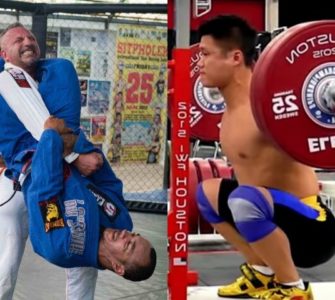Brazilian Jiu-Jitsu (BJJ) is a multidimensional sport. The activity demands a high level of strength, power, endurance, and flexibility.
This has led to a rise in certain training practices by many BJJ athletes. Weight training, plyometrics, running, and calisthenics are all becoming staples of training.
An often overlooked aspect of a training program is injury prevention. BJJ athletes are at risk from injuries to the groin, shoulder, ankles and even knees. Fortunately, injury prevention is rapidly becoming one of the biggest focuses of training in other sports. This is for good reason too, as recovering from injury can cost time and money.
It can also keep you out of competition and prevent you from winning a title. In short, all the strength, power and endurance in the world is useless if injury keeps you out of competition.
So, we put together the top 3 tips for injury prevention you should use when designing a program. These will help keep you in competition and in training so you can improve your preparation and performance.
3 Tips For Preventing Injury in Brazilian Jiu-Jitsu
-
Manage Your Training Load
This is easily the most important tip for preventing any injury. Training load is simply the name given to how much training, and the intensity of the training, you do. So, carrying out a lot of training at high intensity means you’re training load is high.
A high training load has been shown to be a key factor in injury. The most common theories behind why this is include higher fatigue and decreased perception when training. This basically means that sufficient recovery is needed between bouts of training, or competitions.
So, managing your training load is essential in preventing injury. There are two main ways of doing this:
-
Reducing Your Training Load
The most obvious, and common, way is to reduce training load. This is done by including more rest days, decreasing training intensity, or decreasing training volume.
But, this is not always an option for high-level BJJ athletes or those in competition. For them, competitions can’t be postponed and important training sessions take priority. This brings us to the second option.
-
Accelerating Recovery
By improving sleep and boosting nutrition through supplementation, you can improve recovery. This can be done with whey protein from Scitec or other well-known companies. Supplementing with gelatin and Vitamin C might also help prevent tendon injury.
This means you can sufficiently recover in less time and get back to training and competition quicker.
So, for athletes on a deadline, accelerating recovery and managing training loads are the best ways to prevent injury.
-
Improve Your (Eccentric) Strength
Another popular and effective method for preventing injury is to develop strength in the at-risk muscles. Stronger muscles can handle more load and don’t fatigue quickly. They also recover faster. But, this is only half the battle.
Many injuries occur during the eccentric phase of a movement, as the muscle is lengthening. So, doing exercises that strengthen the muscles as it’s stretching or lengthening has been found to be the most beneficial.
Exercises like Nordic hamstring curls, lateral squats, and external rotations can help keep injury at bay. This should be combined with conventional weight training for maximum benefit.
-
Improve Your Pre-workout And Pre-fight Preparation
Another basic, yet effective, method of preventing injury risk is improving your warm-up. A good warm-up can not only help boost performance, but also reduce risk of injury.
Yet, many warm-ups receive little attention. They are often carried out using general exercises without much concentration or effort.
A good warm-up should use general exercises first, before using sport-specific movements like light rolling or with a bag or dummy. This should also be combined with mobility exercises like foam rolling and dynamic stretching.
Combining these methods will help raise body temperature, improve blood flow and boost suppleness to help you feel better on and off the mat.
Wrap Up And Take Home Points
As a BJJ athlete, you’re at risk of a wide range of injuries. These can keep you out of competition and cost you time and money.
So, avoiding these injuries should be your top priority. The best ways to do this are to manage training load, do regular strength training and carry out a full warm-up.
Working with your coach and using a strength and conditioning coach or physiotherapist can be very helpful when taking the above steps.
That way, you can focus on performing at your best at every session and event, without worrying about nasty injuries.
Stop Feeling Sore, Tired, And Injured And Start Being Preventative With Your Injuries. It’s Time To Become Bulletproof For BJJ!
- Get grappling-specific exercise routines to build mobility, strength, grip, and core, with or without a gym
- This system was designed by BJJ brown and black belts and professional fitness gurus Joe Worthington and James Tomlinson
- Get different exercises, sets, reps, and more to keep your workouts fresh and dynamic:



















